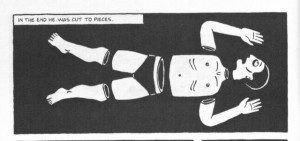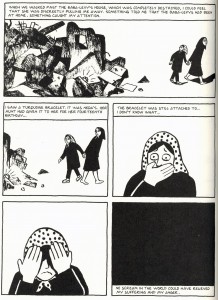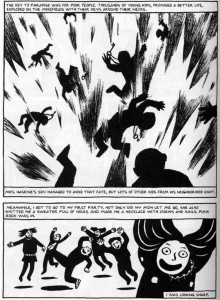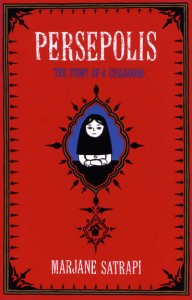“Simplicity is about subtracting the obvious and adding the meaningful.”
― John Maeda
This week our ASTU class continued reading Marjane Satrapi’s book – ‘Persepolis’. With new perspectives and topics coming up in our discussions, I would like to talk more about the format and style of this graphic narrative in the following post. I used the article written by a scholar and critic, Hillary Chute as a source of my inspiration. In her work she analyses verbal and visual techniques used by Satrapi.
Usually people have a set of stereotypes about the genre of comic books. Mine was narrowed to the idea of comics being books for teenagers, who do not want to spend their time on reading ‘normal’ literature. However, having read ‘Persepolis’, I realized how much mistaken I was. This genre can not only be used in educative purposes, but it also enriches one’s mind by providing an uncommon perspective at usual things.
‘Persepolis’ is a unique and authentic piece of art. As the majority of people tend to judge a book by its cover, it is essential to tell that the cover of ‘Persepolis. The story of a Childhood’ is the most colorful part of the book. The bright red background attracts a reader and scares them at the same time. The aggressiveness it holds serves as a pre-introduction to the story. It is followed by the panels, which are depicted in a violent but simple way. The events described in the book are serious and traumatic. This combination of trauma and a naïve perspective of a child are contradicting, but thanks to them a special, even more realistic setting appears before a reader. In such a way, the design and colors work to reflect author’s attitude towards the tragedy happening in her country. Anoth er thing to consider is the use of traditions of Persian art in Persepolis. As Chute argues these avant-garde patterns ‘call attention to the horror of history’. The same techniques Satrapi uses in her book were used in German Expressionism. ‘German Expressionism is an artistic genre that originated in Europe in the 1920s, and is broadly defined as the rejection of Western conventions, and the depiction of reality that is widely distorted for emotional effect.’
er thing to consider is the use of traditions of Persian art in Persepolis. As Chute argues these avant-garde patterns ‘call attention to the horror of history’. The same techniques Satrapi uses in her book were used in German Expressionism. ‘German Expressionism is an artistic genre that originated in Europe in the 1920s, and is broadly defined as the rejection of Western conventions, and the depiction of reality that is widely distorted for emotional effect.’
 Minimalism is an outstanding feature of ‘Persepolis’ that creates a particular atmosphere of the story.
Minimalism is an outstanding feature of ‘Persepolis’ that creates a particular atmosphere of the story.
The use of black and white makes the representation of the events more accurate. It has a strong influence on the way a reader perceives the story. Satrapi explains: ‘Violence today has become something normal, so banal – that is to say everybody thinks it’s normal. But it’s not normal. To draw it and put it in color – the color of flesh and the red of the blood, and so forth – reduces it by making it realistic’ (Hajdu 2004,35).
The form of telling a story is as significant as the content is. Putting the story of one’s life into small black and white boxes takes courage, especially if it is your own story. However, it doesn’t necessarily mean that such a way of story telling is a shortcoming. Minimalism can be used in graphic narrative as a tool providing a space for the undistorted representation of events.
Works cited:
Chute, Hillary. “The Texture of Retracing in Marjane Satrapi’s Persepolis.” Project Muse – WSQ: Women’s Studies Quarterly – Volume 36, Numbers 1 & 2, Spring/Summer 2008. Project Muse, n.d. Web. 15 Oct. 2015.
Hajdu, David. “Persian Miniatures.” Articles by David Hajdu. BookForum, 2011. Web. 15 Oct. 2015.

